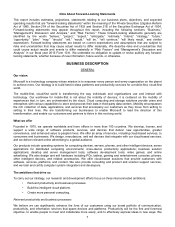Microsoft 2015 Annual Report Download - page 12
Download and view the complete annual report
Please find page 12 of the 2015 Microsoft annual report below. You can navigate through the pages in the report by either clicking on the pages listed below, or by using the keyword search tool below to find specific information within the annual report.
11
Devices and Consumer
Our D&C segments develop, manufacture, market, and support products and services designed to entertain and
connect people, increase personal productivity, help people simplify tasks and make more informed decisions online,
and help advertisers connect with audiences. Our D&C segments are made up of D&C Licensing, Computing and
Gaming Hardware, Phone Hardware, and D&C Other.
D&C Licensing
The principal products and services provided by the D&C Licensing segment are: Windows, including all OEM
licensing (“Windows OEM”) and other non-volume licensing and academic volume licensing of the Windows
operating system and related software; non-volume licensing of Microsoft Office, comprising the core Office product
set, for consumers (“Office Consumer”); Windows Phone operating system, including related patent licensing; and
certain other patent licensing revenue.
The Windows operating system is designed to deliver a more personal computing experience for users by enabling
consistency of experience, applications, and information across their devices.
Windows revenue is impacted significantly by the number of Windows operating system licenses purchased by
OEMs, which they pre-install on the devices they sell. In addition to computing device market volume, Windows
revenue is impacted by:
• The mix of computing devices based on form factor and screen size.
• Differences in device market demand between developed markets and emerging markets.
• Attachment of Windows to devices shipped.
• Customer mix between consumer, small- and medium-sized businesses, and large enterprises.
• Changes in inventory levels in the OEM channel.
• Pricing changes and promotions, pricing variation that occurs when the mix of devices manufactured
shifts from local and regional system builders to large, multinational OEMs, and different pricing of
Windows versions licensed.
• Piracy.
The versions of Office included in our D&C Licensing segment are designed to increase personal productivity
through a range of programs, services, and software solutions. Growth depends on our ability to add value to the
core product set and to continue to expand our product offerings in other areas such as content management and
collaboration. Office Consumer revenue is impacted by sales to customers that buy Office with their new devices and
by product launches, as well as the transition to Office 365 Consumer, our subscription-based cloud service that
provides access to Office plus other productivity services. Office 365 Consumer revenue is included in our D&C
Other segment.
The Windows Phone operating system is designed to bring users closer to the people, applications, and content they
need. As noted above, prior to our acquisition of NDS, Microsoft and Nokia jointly created new mobile products and
services and extended established products and services to new markets through a strategic alliance. Windows
Phone revenue associated with this contractual relationship was reflected in D&C Licensing. Windows Phone
revenue also includes revenue from licensing mobile-related patents.
Competition
The Windows operating system faces competition from various software products and from alternative platforms and
devices, mainly from Apple and Google. We believe Windows competes effectively by giving customers choice,
value, flexibility, security, an easy-to-use interface, compatibility with a broad range of hardware and software
applications, including those that enable productivity, and the largest support network for any operating system.
Competitors to the versions of Office included in D&C Licensing include global application vendors such as Apple
and Google, numerous web-based and mobile application competitors, and local application developers in Asia and
Europe. Apple distributes versions of its pre-installed application software, such as email, note-taking, and calendar
products, through its PCs, tablets, and phones. Google provides a hosted messaging and productivity suite. Web-
based offerings competing with individual applications can also position themselves as alternatives to our products.
We believe our products compete effectively based on our strategy of providing powerful, flexible, secure, and easy
to use solutions that work across a variety of devices.
























